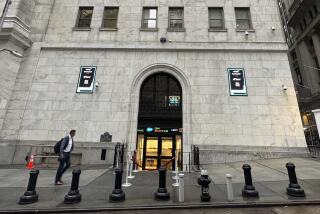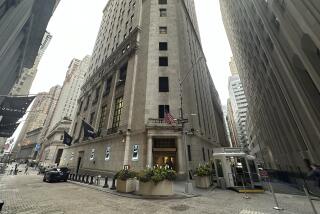Stocks Show Surprising Strength During Historically Weak Month
“Sell in May and go away,” advises one Wall Street adage. But those who followed that advice and unloaded stocks recently might be feeling a twinge of regret.
Amid a pullback in oil prices, healthier-than-expected corporate earnings reports and some upbeat economic data, the Standard & Poor’s 500 index has climbed more than 5% from its 2005 low reached April 20.
The blue-chip benchmark settled Friday within easy reach of the 3 1/2-year high it notched in early March.
Other stock indexes also have posted hefty gains this month. The technology-heavy Nasdaq composite has risen four straight weeks and is up 9% since April 28, although like most market gauges it still is in the red year to date.
The market’s recent strength runs counter to the historical trend. Since 1950, May typically has been a lousy month for stocks, and relatively poor performance often has continued through the summer months and early fall, according to Hirsch Organization Inc., a data tracker in Old Tappan, N.J.
That has given rise to the “sell in May and go away” idea: Over the last five decades, investors would have been far better off buying stocks Nov. 1, selling the following April 30 and repeating that pattern yearly than buying and holding, the Hirsch group says.
But the strategy hasn’t worked every year, and this one also may prove an exception, according to some Wall Street pros.
They say corporate profit growth may be slowing less sharply than some investors expected; oil prices, despite a rebound last week, are showing signs of stability in the $50-a-barrel range; stock valuations appear reasonable by historical standards; and the Federal Reserve may be nearing the end of its credit-tightening campaign.
“We’re already into an atypical year,” said Tobias Levkovich, U.S. equity strategist at Citigroup Inc.’s Smith Barney brokerage unit, noting that stocks fell in the first quarter, which usually is a strong period.
“We see an environment where things could get much better,” said Levkovich, whose firm expects the S&P; 500 to reach 1,300 by year’s end. That would be a gain of 8.4% from Friday’s closing level.
Corporate earnings have provided a boost for market optimists. Operating profit for the S&P; 500 companies rose 13.8% in the first quarter, according to data firm Thomson First Call. That far exceeded the 8% growth that Wall Street analysts had predicted as of April 1.
Levkovich’s strategy team last week raised its 2005 operating-profit estimate for the S&P; 500 to $73.25 per S&P; index share from a previous estimate of $72.25. Other major brokerages are in the same ballpark with their estimates, Thomson First Call data show.
At Friday’s close of 1,198.78, the S&P; 500’s price-to-earnings ratio, or P/E, is about 16 based on Smith Barney’s earnings estimate for this year. That matches the market’s historical average P/E, which suggests that stocks are reasonably priced, market bulls say.
What’s more, falling long-term interest rates make stocks look more appealing at current price-to-earnings ratios, some analysts say. The 10-year Treasury note yield, a benchmark for other long-term interest rates, ended Friday at 4.08%, down from 4.45% on April 1.
The bond market may be betting that Fed Chairman Alan Greenspan and his colleagues will need to make only one or two more of their “measured,” quarter-point increases in short-term lending rates, said Alfred E. Goldman, director of market analysis at brokerage A.G. Edwards & Sons Inc. in St. Louis.
The Fed’s key short-term rate now is 3%, up from 1% a year ago. Barring a surge in the economy or inflation, Goldman said he expected the Fed to stop raising rates at the 3.5% mark. That would mean two more increases, including one that is widely expected at the central bank’s June 29 and 30 meeting.
But some economists believe the Fed could keep lifting rates through this year and into 2006. Although oil prices have pulled back from $57 a barrel in April to $51.85 as of Friday, the potential inflationary effects could keep rippling through the economy, said Shelly J. Meyers, manager of the Pacific Advisors Multi-Cap Value stock fund in Glendale.
“The step-up onto a higher sustained level of energy prices hasn’t played out yet,” Meyers said. “It may take at least a couple of months before we know for certain what the impact will be,” she said.
“Economic outlooks are changing on a dime with every new release,” said Jay Wong, co-portfolio manager at investment firm Payden & Rygel in Los Angeles. “In order for this [stock] rally to be sustainable, we’re going to need more confirmation in terms of the Fed and inflation.”
This week, the most important economic statistic will be the May employment report from the Labor Department, due Friday. A big gain in jobs could boost optimism about the economy but also could raise concerns about how much more credit tightening the Fed will do.
The economic uncertainty, along with stocks’ choppy performance since the start of 2004, has left many investors dubious about the current rally.
Levkovich said his analysis of overall market sentiment -- as measured by investor surveys, short selling of stocks (bets on lower prices) and other data -- showed one of the most pessimistic readings in years, worse than after the Sept. 11, 2001, terrorist attacks or at the start of the Iraq war in 2003.
One indication of investors’ loss of interest in stocks: The net cash inflow into stock mutual funds was $56.1 billion in the first four months of this year, down from $107.7 billion in the same period in 2004, according to the Investment Company Institute.
“People don’t have a palpable fear, but there is a deeply rooted skepticism,” Levkovich said. But that is another reason to be bullish about the next six to 12 months, he said, because stock rallies often happen when most investors aren’t expecting them.
“Even the bulls are just cautiously optimistic these days,” said Goldman, who counts himself in that camp. “When you’re uncomfortable about buying stocks, that’s when you should be buying them,” he said.
Goldman -- who claimed to have eaten lunch at his desk every day for 45 years -- said even his unofficial “Goldman gastronomic gauge” was showing an encouraging dose of queasiness last week as the market climbed.
“I’m not about to lose my lunch, but I’m still feeling a little dyspeptic,” he said.
More to Read
Inside the business of entertainment
The Wide Shot brings you news, analysis and insights on everything from streaming wars to production — and what it all means for the future.
You may occasionally receive promotional content from the Los Angeles Times.










